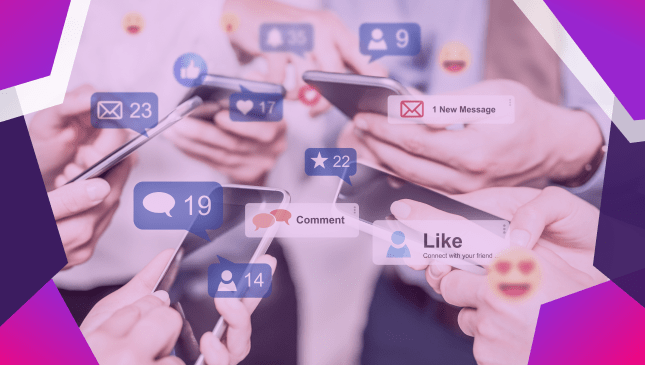Social Bots: How Do They Shape Public Opinion?
Sanja Trajcheva
|Cyber Risks & Threats | July 12, 2023

Social bots have become an integral part of social media platforms, seamlessly blending into our daily lives.
They come in all shapes and sizes, from the ones trying to sell you the latest gadgets to the ones pushing their own agenda.
These bots are pros at spreading their messages and tricking us into believing they’re real people. It’s like they’re the puppet masters behind the scenes, skillfully pulling strings and manipulating discussions.
Let’s dig a little deeper into why they do this and why it matters.
What are bots on social media platforms?
In simple terms, social bots are automated programs designed to mimic human behavior on social media networks.
Most often, these types of bots are associated with fake social media profiles, business accounts, or pages. That’s why they’re often referred to as social media bots. Those so-called social media users enthusiastically participate in heated debates on various social media posts or engage in spam-like activities.
But before we delve deeper into this topic, it’s important to note that just like any other type of bot, there are both good and bad social media bots out there.
The good ones are helpful bots, which are integral components of various automation tools. They are designed to assist with everyday tasks that businesses carry out on social media.
Take chatbots, for example. It’s no doubt that they play a significant role in supporting customer support teams. They can initiate a conversation with visitors, ensuring that there’s a friendly interaction even before a customer support representative is available to respond personally.
However, more commonly, when discussing social bots, we refer to the not-so-good ones. These bots often operate as part of a network, working towards a single goal. And when they join forces, they create what’s known as a botnet.
This botnet is controlled by a person called a botmaster who uses social media to send automated tasks to its bots.
We talk more about botnets in this article.
The botnets engage in activities such as posting comments, adding likes, or generating fake followers on social media.
But why are they considered harmful? It all boils down to the intentions behind these interactions, which usually are deceptive or harmful. According to the European Parliament:
“Fake accounts and bot networks contribute to the spread of disinformation, online manipulation, and polarisation, and can therefore pose a direct threat to democracy.”
What are social bots used for?
As the name itself suggests, social bots are designed to ‘live’ and operate on social media platforms. They are most common on Twitter due to the limited length of the tweets, according to what IONOS has stated in their article here.
However, there’s almost no platform that’s not home to social bots. They are present on Facebook, Instagram, TikTok, and other social media platforms as well.
As software agents on social media, their purpose is to act as ‘social’ entities. Therefore, they can execute different tasks based on their goal – read, the goal of the people behind them.
Here are some common use cases they perform:
Spread of misinformation: These automated social media accounts can disseminate false or misleading information, leading to the spread of misinformation among social media users.
Manipulation of public opinion: By generating a large volume of posts, comments, and likes, social media bots can create the illusion of widespread support or opposition for a particular viewpoint, swaying public opinion in a desired direction.
Political polarization: They can contribute to the polarization of political discourse. By promoting extreme views, they are influencing people to accept these viewpoints, which creates additional divisions groups in society.
Cyberbullying and harassment: Some other types of social media bots can be programmed to engage in online harassment. They can spread hate speech, threats, and malicious content, contributing to a toxic online environment.
Fraudulent activities: A social media bot can be employed to carry out fraudulent activities. These can be anything from spamming, phishing, identity theft, click fraud, abandonment fraud, and exploiting unsuspecting users for personal gain.
Stock market manipulation: Some of these bots are spreading false information about companies, affecting stock prices, and potentially enabling insider trading or other forms of market manipulation.
Influence on brand reputation: Social bots can be utilized to tarnish the reputation of individuals, organizations, or companies by spreading negative reviews, defamatory content, or false accusations.
Erosion of trust: The presence of a social media bot can erode trust in online interactions and social media platforms, as users may become skeptical of the authenticity of the accounts and the reliability of the information.
How many social media users are bots?
There’s no exact estimation of the volume of fake social media accounts out there, but undoubtedly, it’s a significant concern.
Just on Twitter, for example, it was estimated that around 15% of all users in 2017 were bots. More recent research from 2022 conducted by professors at Washington University in St. Louis suggests that bots account for 25–68% of Twitter users.
Twitter management, on the other hand, is claiming only 5% of Twitter accounts are controlled by bots. But again, another research by Similarweb presents a different perspective. It indicates that even within this limited figure, bot accounts contribute to a significant portion of the content posted on Twitter, ranging from 20.8% to 29.2%.
This sizable number indicates the level of influence these bot accounts can have on public opinion and raises questions about the authenticity of information on social media.
Social bots’ role in public discussions
The controversies surrounding social media bots are enormous. Most widely, their presence can be recognized around sensitive topics such as politics, health, or global warming.
Many studies show how low credibility information is easily spread, shaping online discussions in a very subtle way. But how is this achieved?
One thing is that social bots fabricate content on a large scale, leading to fake news websites. In addition, they also harness the power of social media to amplify the reach of their messages.
By engaging in activities such as retweeting and sharing their content, they manipulated the algorithms responsible for determining trending topics on social media platforms.
But the fraudsters behind these bots don’t forget the power of hashtags and keywords as well. They manage to generate a large number of tweets or posts on any topic they desire.
As a result, these manipulated trends became highly visible to users, potentially influencing the public discourse.
Real-world cases
You have probably heard that social bots played a significant role in the US presidential elections back in 2016. It was one of the most notable cases where these bots ‘exerted’ their influence.
But there are many other cases about which the public is not aware.
For example, this study reveals the impact that social bots had in raising the popularity of e-cigarettes.
The researchers have used advanced machine learning methods to analyze Twitter accounts and tweets around the topic of e-cigarettes and smoking. They relied on behavior patterns, social interactions, language sentiment, and other factors to distinguish bots from human activities.
As a result, they found out that bot accounts were more likely to promote the idea that e-cigarettes are helpful.
Another example is the 2017 Catalan referendum for independence. According to a study published by Proceedings of the National Academy of Sciences (PNAS), social bots had a massive influence on the referendum.
This study examined a vast amount of social media data related to the referendum and identified two distinct groups: the Independentists and the Constitutionalists.
The findings showed that bots played a crucial role in amplifying negative and inflammatory content among both the Independentists and the Constitutionalists. Through their activities, the bots were able to create and disseminate deceptive information, spread misinformation, and fuel polarization.
How to recognize social bots
Recognizing social bots can sometimes be challenging, as they are designed to behave like real humans online. However, some patterns can easily uncover their nature.
The NIH team, for example, has used some pretty fascinating tactics while working on the COVID-19 and social bots research case.
Profile information: Bots often have incomplete or generic profile information. Look for indicators such as a lack of profile pictures, limited bio, or repetitive phrases.
Activity patterns: A high level of activity within a short period is not so typical for legitimate users. Additionally, bots can also be noticed as being active throughout the day without any breaks.
Content quality: Bots typically generate low-quality or nonsensical content. Usually, they also don’t make grammatical mistakes, which are quite common for human users.
Lack of engagement: Bots often have a minimal level of engagement with other users. They may not respond to comments or messages, and their interactions may seem scripted or generic.
Amplification of specific content: A social bot may exhibit a pattern of amplifying specific types of content, such as political propaganda or commercial promotions. They often lack diversity in the topics they engage with and share.
Can bots on social media hurt your business?
Social bots have a significant impact not only on shaping public opinion around some public topics but they also affect the entire online ecosystem, including your business.
Similar to how they spread political propaganda or conspiracy theories, fake social media accounts can also share false information on social media platforms and review sites. For instance, they can be employed to generate negative reviews for your products or services.
Furthermore, these bots trick algorithms into prioritizing their content and topics, reducing the reach of authentic content from real users like your business.
Consequently, your reputation may suffer, potential and existing customers may be lost, and you might find yourself spending more on paid ads.
It’s crucial to be aware of these potential risks and take necessary measures to protect your business and maintain a positive online presence.
When it comes to some types of fraudulent activities on social media, like fake clicks, click fraud, or ad fraud, CHEQ Essentials is a tool that can defend your digital presence. It is designed to detect and block bot accounts from interacting with your business online.
Bottom line
Undoubtedly, social bots have emerged as a crucial element within intricate social networks. They now play the role of an “invisible hand,” exerting a sophisticated and profound influence on public opinion.
This shift marks a transition from a scenario dominated solely by human interactions to a novel model of interactive symbiosis between humans and social bots.
It’s important to mention that social media platforms are actively taking measures and suspending large numbers of fake accounts.
However, these bots are still here, and their presence will probably never be taken completely out…
To keep your business one step ahead of these harmful entities and malicious bots, try CHEQ Essentials’ bot mitigation solution.
It will protect your social media marketing efforts, helping you remain safe from social bots and maintain an authentic and trustworthy online presence.
















